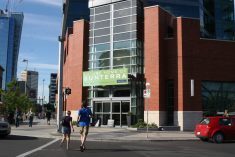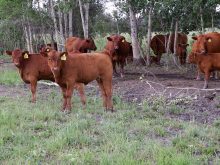REGINA – A week away from home to attend a farm show can be a grueling and exhilarating experience for a family.
Canadian Western Agribition is the main event for the Fornwalds of Lampman, Sask., to showcase their polled Herefords.
Blair and Laurel Fornwald bring 10 bulls and females to Regina, and with their sons Darnell and Dustin, Dustin’s wife, Kirsten, cousins and friends, they handle their own grooming, fitting and showing.
Daughter Ashton has a career off the farm but drops into the show when she can.
Read Also

Trade war may create Canadian economic opportunities
Canada’s current tariff woes could open chances for long-term economic growth and a stronger Canadian economy, consultant says — It’s happened before.
Fornwald’s Meadow Acres Herefords was formed 19 years ago with 10 cows. Their first trip to Canadian Western Agribition was seven years ago.
“We came one year and we didn’t do that well. We decided we weren’t ready, so we took a year off,” Laurel said.
Now it is an annual event, where everyone shows up. In the early years, the children did their homework in the barns or caught up when they returned to school the following week.
With experience, they have learned to pace themselves.
Agribition was held in Regina Nov. 21-28 and Hereford events are at the end of the week, so every day family members are up before sunrise cleaning stalls and preparing to show cattle in their finest form. Lucrative deals for live animals, semen and embryos can be made at individual stalls, so the cattle and the family need to be at the top of their game.
Six of the Fornwalds’ 10 entries are from embryo transfers, and the sires are prominent Hereford bulls. It is all part of a larger promotion plan to sell purebred breeding stock.
Sale day was Nov. 26, and they sold two females for $4,000 and $2,300. One of the buyers, Jason Rimke of Oak Lake, Man., was commandeered to help.
Nov. 27, was show day.
It was hectic because they had 10 head to show, including four in one class. They went to bed at 9 p.m. and still slept in.
“We were supposed to be here at 2 a.m. but we forgot to set the alarm,” Laurel said.
Most of the crew made it to the barns by 3 a.m. to get ready by 10:30 a.m. for the large national Hereford show.
Everyone from the family came to watch, including a six-month-old granddaughter who was decked out in a pink cowboy shirt. Four heifer calves ultimately took second to fifth place in a single large class.
The Hereford Red Coat show staged after the national show ran late and the family didn’t get to bed until after 11 p.m.
Nov. 28 was the Junior Beef Extreme show, where 20-year-old Darnell had two entries. One of his heifers won reserve grand champion in the Hereford division.
When the hectic pace of Agribition was finally over, the Fornwalds returned to Lampman and their 100 purebred polled Herefords and 50 commercial cattle, which includes some Angus breeding. They’ll also start planning for the next year.
Farming wasn’t easy this past year.
Only 100 millimetres of rain fell and there was frost on June 10. They bought standing hay on 550 acres to get extra feed, but the grain crops survived.
“The grain crops were the best we ever had,” Blair said.
Besides planning next year’s crops, they also continue improving the genetic base of their herd. They placed 29 embryos this past year.
Blair believes in using the best bulls he can find, and then using artificial insemination and natural breeding to get the results he wants. The program appears to work because they have sold cattle all over North America.
“We try to run the best bulls we can but whenever seeding starts, that’s when we stop AI’ing,” he said.
Seeding was early in 2008 so the program ended April 25, but this year delays allowed them to continue until May 13. The goal is to have January and February calves.
Blair and Laurel are still young, but they are building a foundation for their children. Sons Dustin and Darrell have both worked off the farm but their preference is a career in agriculture.
“Even though they can make more money working in the oil patch, it is not what they want to do,” Laurel said.
Being a tight knit, hard working family has given the children a strong work ethic who value togetherness. Farming as a larger unit works for them.
“That’s the way it should be, farming as a unit,” Blair said.















